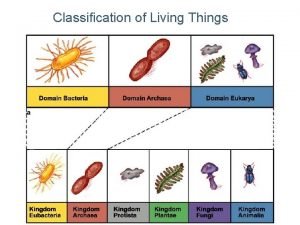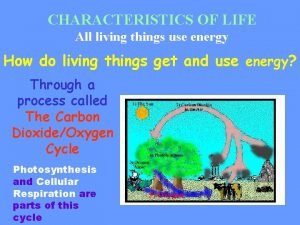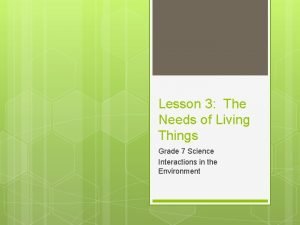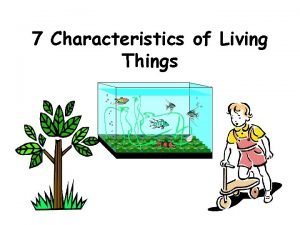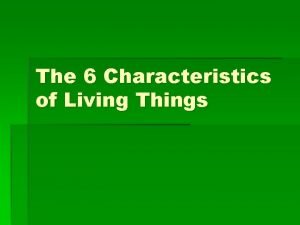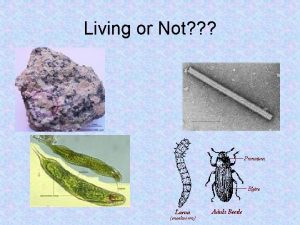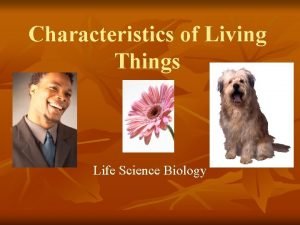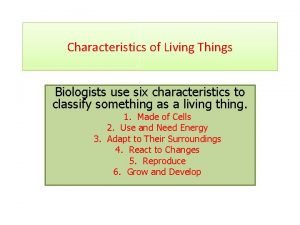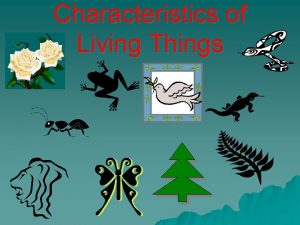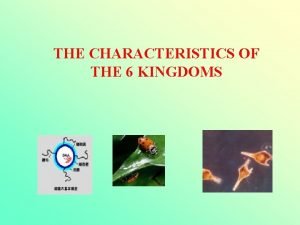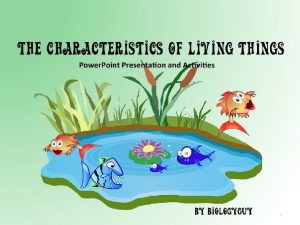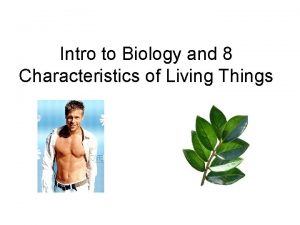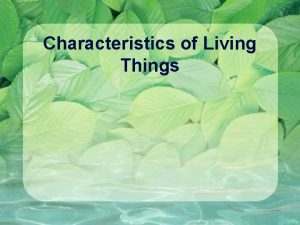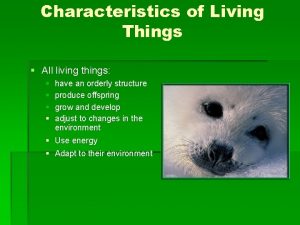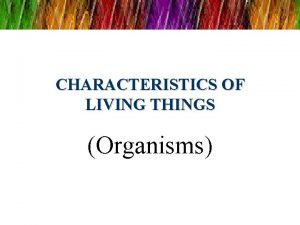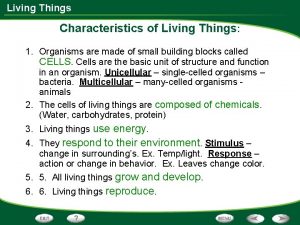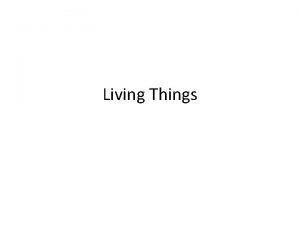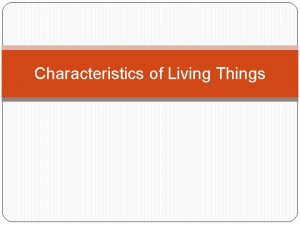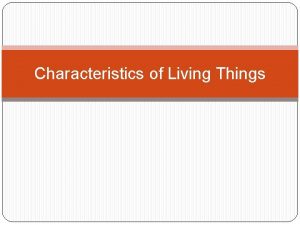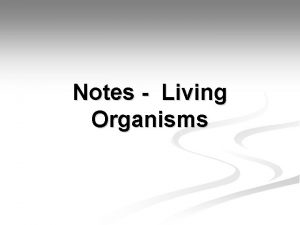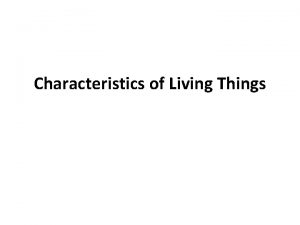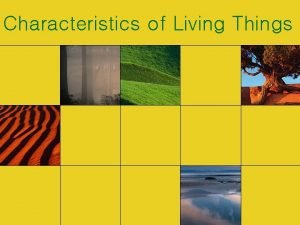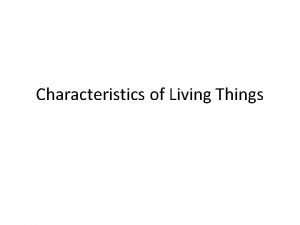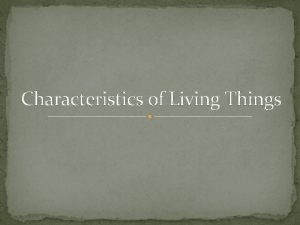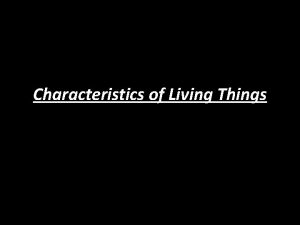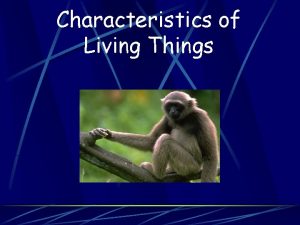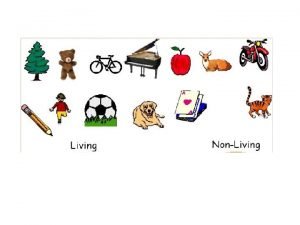Characteristics of Living Things What all organisms have





















- Slides: 21

Characteristics of Living Things What all organisms have in common

Characteristics of Living Things All ORGANISMS share common characteristics. • Made of Cells • Chemicals of Life (Genetic Material) • Reproduce • Grow and Develop • Obtain and Use Energy • Respond to their Environment • Maintain Homeostasis • As a group, Evolve

Vocabulary Organisms: a living thing Abiotic Biotic • Non-living things in the environment • Examples: water, soil, sunlight, oxygen, carbon dioxide May have some, but not all of the characteristics of living things • Living • Organisms: living things in the environment • Have all of the characteristics of life

Made of Cells • Cell: basic unit of structure and function in an organism • Unicellular: made up of one cell (ex. Bacteria) • Multicellular: many cells (ex. Human)

Chemicals of Life ▫ The cells of living things are all made of chemicals ▫ Cells are made up mostly of water

Reproduce ▫ Produce offspring that are similar to the parents ▫ Asexual (1 parent ) and sexual (2 parents) ▫ Make more of a species

Asexual

• The Dividing Starfish - Bing video

Sexual

Growth and Development • Growth: the process of getting larger • Development: a process of change that occurs throughout an organisms lifetime

Obtain and Use Energy • Organisms require energy to go through life’s processes • Need energy for growth, repair and daily activities • Autotrophs ▫ “self-feeder” ▫ Make and use own food ▫ Example: plants • Heterotroph ▫ “other-feeders” ▫ Must get energy by eating autotrophs or other heterotrophs ▫ Examples: animals, mushrooms, slime molds

Energy

Respond to the Environment • Stimulus: something that causes an organism to react ▫ Ex. Changes in light, temperature, light and sound • Response: an action or change in behavior ▫ Ex. Movement, sweating, blinking

Homeostasis • Maintaining stable internal condition �Example: sweating to cool your body down �Example: shivering to warm up �Without homeostasis organisms will be sick or die

Evolution • Evolution: A gradual change in a species overtime



Needs of Living Things • Energy • Water • Living Space • Stable internal Conditions (Homeostasis)

Vocab • Transportation: Movement of materials • Excretion: removal of waste materials from a cell (urine, sweat) • Metabolism: all chemical reactions in an organism • Nutrition: body takes in and uses food • Synthesis: combinations of parts to make a whole

Youtube • https: //www. youtube. com/watch? v=r. Fw 0 c. CJd 7 2 Y

• http: //www. bing. com/videos/search? q=animals +adapting&&view=detail&mid=68282 E 662065 0 C 5 E 2 A 0768282 E 6620650 C 5 E 2 A 07&&FORM= VRDGAR
 What is the smallest living unit in all organisms?
What is the smallest living unit in all organisms? Seven processes of living things
Seven processes of living things Pyramid hesd
Pyramid hesd 8 levels of classification in order
8 levels of classification in order Tissues group together to form
Tissues group together to form Life cycle of all living things
Life cycle of all living things What are the 5 basic needs of all living things
What are the 5 basic needs of all living things Are all living things based on the metric system
Are all living things based on the metric system All living things 1955
All living things 1955 Which part of the plant carries and protects the seed
Which part of the plant carries and protects the seed 7 characteristics of life
7 characteristics of life 6 characteristics of living things
6 characteristics of living things Movement characteristics of living things
Movement characteristics of living things Six characteristics of living things
Six characteristics of living things List the six characteristics of living things.
List the six characteristics of living things. Two characteristics of living things
Two characteristics of living things Nine characteristics of living things
Nine characteristics of living things Classification of animal kingdom
Classification of animal kingdom Mrs gren activity
Mrs gren activity Characteristics of animals as living things
Characteristics of animals as living things 8 characteristics of living things
8 characteristics of living things Crawl on a single fleshy pad
Crawl on a single fleshy pad



